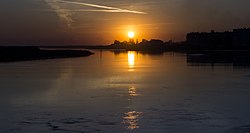Syr Darya
| Syr Darya Jaxartes | |
|---|---|
 Syr Darya atKyzylorda,Kazakhstan | |
 Map of area around the Aral Sea. Aral Sea boundaries are c. 2008. The Syr Darya drainage basin is in yellow, and the Amu Darya basin in orange. | |
| Native name | |
| Location | |
| Country | Kyrgyzstan,Uzbekistan,Tajikistan,Kazakhstan |
| Cities | Khujand, TJ,Tashkent, UZ,Turkestan, KZ,Kyzylorda, KZ,Baikonur, KZ |
| Physical characteristics | |
| Source | Confluence ofNarynandKara Darya |
| • location | Fergana Valley,Uzbekistan |
| • coordinates | 40°54′03″N71°45′27″E/ 40.90083°N 71.75750°E |
| • elevation | 400 m (1,300 ft) |
| Mouth | North Aral Sea |
• location | Kazaly,Kazakhstan |
• coordinates | 46°09′15″N60°52′25″E/ 46.15417°N 60.87361°E |
• elevation | 42 m (138 ft) |
| Length | 2,256.25 km (1,401.97 mi) |
| Basin size | 402,760 km2(155,510 sq mi) |
| Discharge | |
| • average | 1,180 m3/s (42,000 cu ft/s)[1] |
| • minimum | 170 m3/s (6,000 cu ft/s) |
| • maximum | 3,900 m3/s (140,000 cu ft/s) |
| Basin features | |
| Tributaries | |
| • left | Kara |
| • right | Naryn,Chirciq,Arys,Sarysu |
| Protection status | |
| Official name | Lesser Aral Sea and Delta of the Syrdarya River |
| Designated | 2 February 2012 |
| Reference no. | 2083[2] |
 | |

TheSyr Darya(/ˌsɪərˈdɑːr.jə/,Persian pronunciation:[siːɾdæɾˈjɒː]),[a]historically known as theJaxartes(/dʒækˈsɑːrtiːz/,Ancient Greek:Ἰαξάρτης), is a river inCentral Asia.The name, which isPersian,literally meansSyr SeaorSyr River.It originates in theTian Shan MountainsinKyrgyzstanand easternUzbekistanand flows for 2,256.25 kilometres (1,401.97 mi) west and north-west through Uzbekistan and southernKazakhstanto thenorthern remnantsof theAral Sea.It is the northern and eastern of the two main rivers in theendorheic basinof the Aral Sea, the other being theAmu Darya(Jayhun, also known by its classical name theOxus).
In theSovietera, extensive irrigation projects were constructed around both rivers, diverting their water into farmland and causing, during the post-Soviet era, the virtual disappearance of the Aral Sea, once the world's fourth-largest lake. The point at which the river flows from Tajikistan into Uzbekistan is, at 300 m (980 ft) above sea level, the lowest elevation in Tajikistan.[3][4][5]
Name[edit]
The second part of the name (darya,دریا) means "lake" or "sea" inPersianand "river" in theCentral-Asian Persian.The current name dates only from the 18th century.
The earliest recorded name wasJaxartesorIaxartes(Ἰαξάρτης) inAncient Greek,consist of two morphemeIaxaandartes,found in several sources, including those relating toAlexander the Great.The Greek name hearkens back to theOld PersiannameYakhsha Arta( "True Pearl" ), perhaps a reference to the color of its glacially-fed water.[6]More evidence for the Persianetymologycomes from the river's Turkic name up to the time of the Arab conquest, theYinçü,or "Pearl river", fromMiddle ChineseChân châu*t͡ɕiɪn-t͡ɕɨo.[7][8]Tang Chinesealso recorded this name as Yaosha RiverDược sát thủy(MC:*jɨɐk-ʃˠɛt) and later Ye RiverDiệp hà(MC: *jiɛp).
Following theMuslim conquest,the river appears in the sources uniformly as theSeyhun(سيحون), one of the four rivers flowing from theParadise(Jannah,جَنّةinArabic).[9]
The current local name of the river,Syr(Sïr), does not appear before the 16th century. In the 17th century,Abu al-Ghazi BahadurKhan, historian and ruler ofKhiva,called theAral Seathe "Sea of Sïr," orSïr Tengizi.
The important evidence is the etymology of the name of the Syr-Darya River mentioned by the Ancient authors – '''Yaksart''', established by V. A. Livshits (2003: 10). It means ‘'''flowing’, ‘streaming’.''' The word belongs to theSogdiandialect that had emerged from theSakalanguage group.[10]
History[edit]

When the Macedonian army ofAlexander the Greatreached the Jaxartes in 329 BC, after travelling throughBactriaandSogdiawithout encountering any opposition, they met with the first instances of native resistance to their presence. In October 329 BC the Macedonians fought theBattle of Jaxartesagainst theSaka,killing some 1,200 combatants including the leader of the nomads. Alexander was forced to retire south to deal with a revolt inSogdia.Alexander was wounded in the fighting that ensued and the native tribes took to attacking the Macedonian garrisons stationed in their towns. As the revolt against Alexander intensified it spread through Sogdia, plunging it into two years of warfare, the intensity of which surpassed any other conflict of theAnabasis Alexandri.[11]
On the shores of the Syr Darya, Alexander placed a garrison in the City ofCyrus(Cyropolisin Greek), which he then renamed after himselfAlexandria Eschate— "Alexandria the furthest" —in 329 BC. For most of its history since at least theMuslim conquest of Central Asiain the 7th to 8th centuries AD, the name of this city (in present-dayTajikistan) has beenKhujand.
In the mid-19th century, during theRussian conquest of Turkestan,theRussian Empireintroduced steam navigation to the Syr Darya, initially fromFort Raim[12]but with an important river port at Kazalinsk (Kazaly) from 1847 to 1882, when service ceased.
During theSovietera, a resource-sharing system was instituted in which Kyrgyzstan andTajikistanshared water originating from theAmu Daryaand Syr Darya rivers withKazakhstan,Turkmenistan,andUzbekistanin summer. In return, Kyrgyzstan and Tajikistan received Kazakh, Turkmen, and Uzbek coal, gas, and electricity in winter. After the 1991fall of the Soviet Union,this system disintegrated and theCentral Asiannations have failed to reinstate it. Inadequate infrastructure, poor water-management, and outdated irrigation methods all exacerbate the issue.[13]
In 2012, theSyrdarya–Turkestan State Regional Natural Parkwas opened in the Kazakhstan, in hopes of protecting the river plain ecosystems, archaeological sites, and historical-cultural monuments, as well as plants and animal species, some of which are rare or endangered.[14]
Geography[edit]
The river rises in twoheadstreamsin theTian Shan MountainsinKyrgyzstanand easternUzbekistan—theNaryn Riverand theKara Daryawhich come together in the Uzbek part of theFergana Valley—and flows for some 2,212 kilometres (1,374 mi) west and north-west through Uzbekistan and southernKazakhstanto the remains of the Aral Sea. The Syr Darya drains an area of over 800,000 square kilometres (310,000 sq mi), but no more than 200,000 square kilometres (77,000 sq mi) actually contribute significant flow to the river: indeed, two of the largest rivers in its basin, theTalasand theChu,dry up before reaching it. Its annual flow is a very modest[1]37 cubic kilometres (30,000,000acre⋅ft) per year—half that of its sister river, theAmu Darya.
Along its course, the Syr Darya irrigates the most productive agricultural regions in all ofCentral Asia,together with the towns ofKokand,Khujand,KyzylordaandTurkestan.
Various local governments throughout history have built and maintained an extensive system ofcanals.[7]These canals are of central importance in this arid region. Many fell into disuse in the 17th and early 18th century, but theKhanate of Kokandrebuilt many in the 19th century, primarily along the Upper and Middle Syr Darya.
Ecological damage[edit]
Massive expansion ofirrigation canalsin Middle and Lower Syr Darya during theSovietperiod to water cotton andricefields causedecological damageto the area. The amount of water taken from the river was such that in some periods of the year, no water at all reached the Aral Sea. The Amu Darya in Uzbekistan andTurkmenistanfaced a similar situation.
The uranium concentration of the stream water is increased in Tajikistan with values of 43 μg/L and 12 μg/L;[clarification needed]the WHO guideline value for drinking water of 30 μg/L is partly exceeded. The main input of uranium occurs upstream in Uzbekistan and Kyrgyzstan.[15]
See also[edit]
- Extreme points of Tajikistan
- History of the central steppe
- Great Fergana Canal
- Daryalyktakyr
- Jaxartosaurus
Notes[edit]
References[edit]
- ^abDaene C. McKinney."Cooperative Management of Transboundary Water Resources in Central Asia"(PDF).Ce.utexas.edu.Retrieved2014-02-07.
- ^"Lesser Aral Sea and Delta of the Syrdarya River".RamsarSites Information Service.Retrieved25 April2018.
- ^"Tajikistan".The World Factbook.Retrieved30 January2020.
lowest point: Syr Darya (Sirdaryo) 300 m
- ^"Territorial and border issues".Ministry of Foreign Affairs of the Republic of Tajikistan.1 March 2010.Retrieved31 January2020.
The lowest spot of the country is on the height of 300 meters and the highest spot is on the height of 7495 meters above sea level.
- ^"General information about Tajikistan".Conference on Interaction and Confidence-Building Measures in Asia.Retrieved31 January2020.
Tajikistan is a typical mountainous country with absolute heights from 300 to 7495 m.
- ^"Sïr Daryā." Encyclopaedia of Islam, Second Edition. Edited by: P. Bearman, Th. Bianquis, C.E. Bosworth, E. van Donzel, W.P. Heinrichs. Brill Online, 2014.
- ^abВ. В. Бартольд. К истории орошения Туркестана. (On the history of Irrigation in Turkestan) in Работы по исторической географии (Works on Historical Geography). Moscow: Vostochnaia Literatura, 2002. Pages 210-231
- ^Tekin, Talat (1997)."Notes on Some Chinese Loanwords in Old Turkic"(PDF).Türk Dilleri Araştırmaları(7): 165–173.
- ^The introductory chapters of Yāqūt's Muʿjam al-buldān, by Yāqūt ibn ʿAbd Allāh al-Ḥamawī, Page 30
- ^Koryakova, Ludmila (2008-06-01)."Review at Cambridge Core- Elena E. Kuzmina (edited by J.P. Mallory): The Origins of the Indo-Iranians. xviii+762 pages, 132 figures. 2007. Leiden: Brill; 978-90-04-16054-5 hardback".Antiquity Publications.82(316): 457.doi:10.1017/s0003598x00097076.ISSN0003-598X.
- ^Holt, Frank Lee (1989).Alexander the Great and Bactria: The Formation of a Greek Frontier in Central Asia.Brill. p. 53.ISBN9004086129.Retrieved31 March2019.
- ^Gucheval-Claugny, M. (1877)."l'Asie Centrale Et Le Réveil De La Question D'Orient".Revue des Deux Mondes (1829-1971).21(2): 409.ISSN0035-1962.JSTOR44751873.
- ^ International Crisis Group. "Water Pressures in Central Asia",CrisisGroup.org.11 September 2014. Retrieved 6 October 2014.
- ^"Сырдарья-Туркестанский государственный региональный природный парк"[Syrdarya-Turkestan State Regional Natural Park, The History of the Creation of the Regional Park].Биологический Институт(in Russian).Tomsk State University.Retrieved2022-11-01.
- ^Zoriy, P.; Schläger, M.; Murtazaev, K.; Pillath, J.; Zoriy, M.; Heuel-Fabianek, B. (2018). "Monitoring of uranium concentrations in water samples collected near potentially hazardous objects in North-West Tajikistan".Journal of Environmental Radioactivity.181:109–117.doi:10.1016/j.jenvrad.2017.11.010.PMID29136519.
External links[edit]
- Britannica
- Kropotkin, Peter Alexeivitch;Bealby, John Thomas (1911)..Encyclopædia Britannica.Vol. 26 (11th ed.). pp. 303–304.
- Livius.org: JaxartesArchived2014-03-19 at theWayback Machine
- BBC News: Syn Darya in pictures

